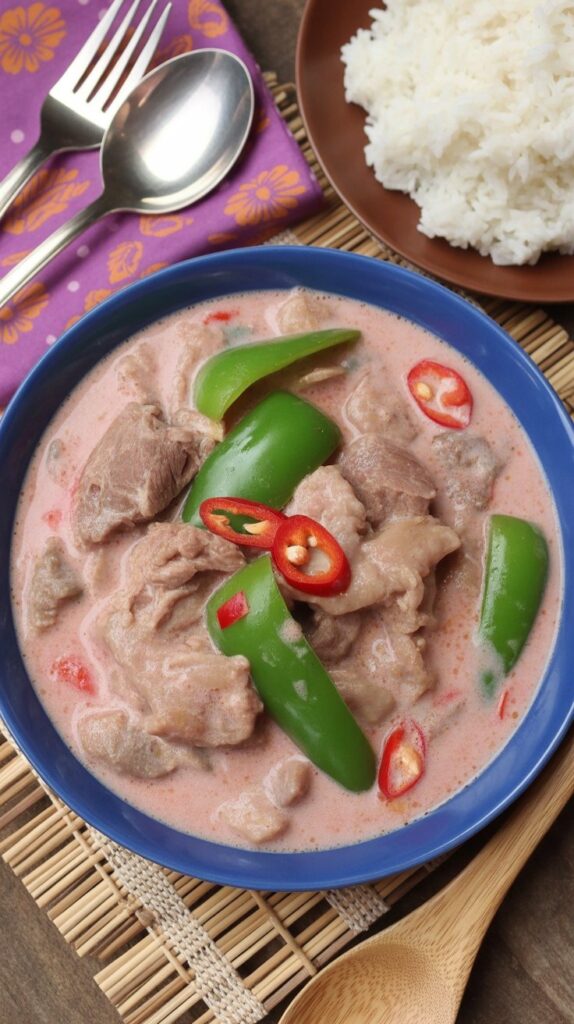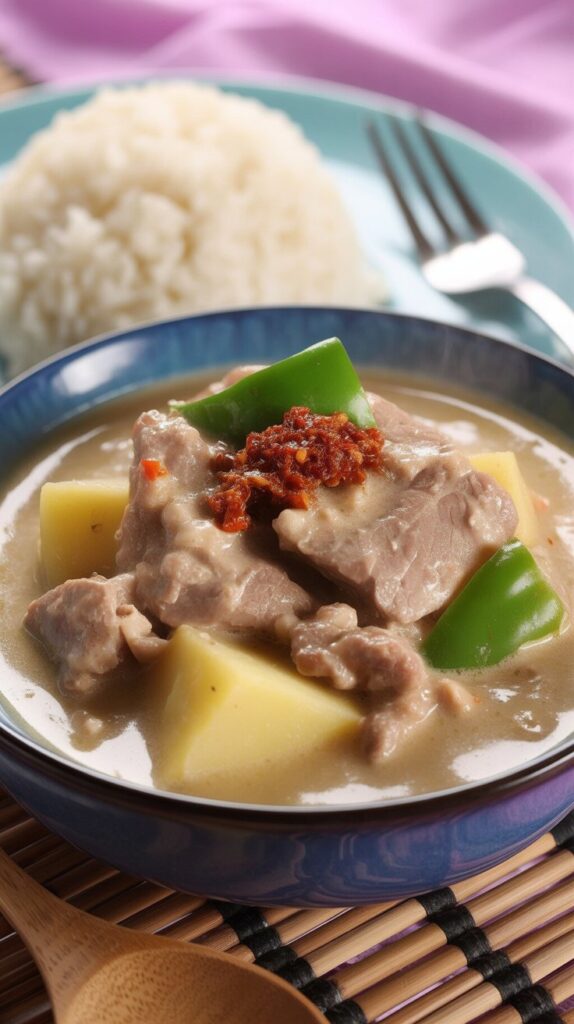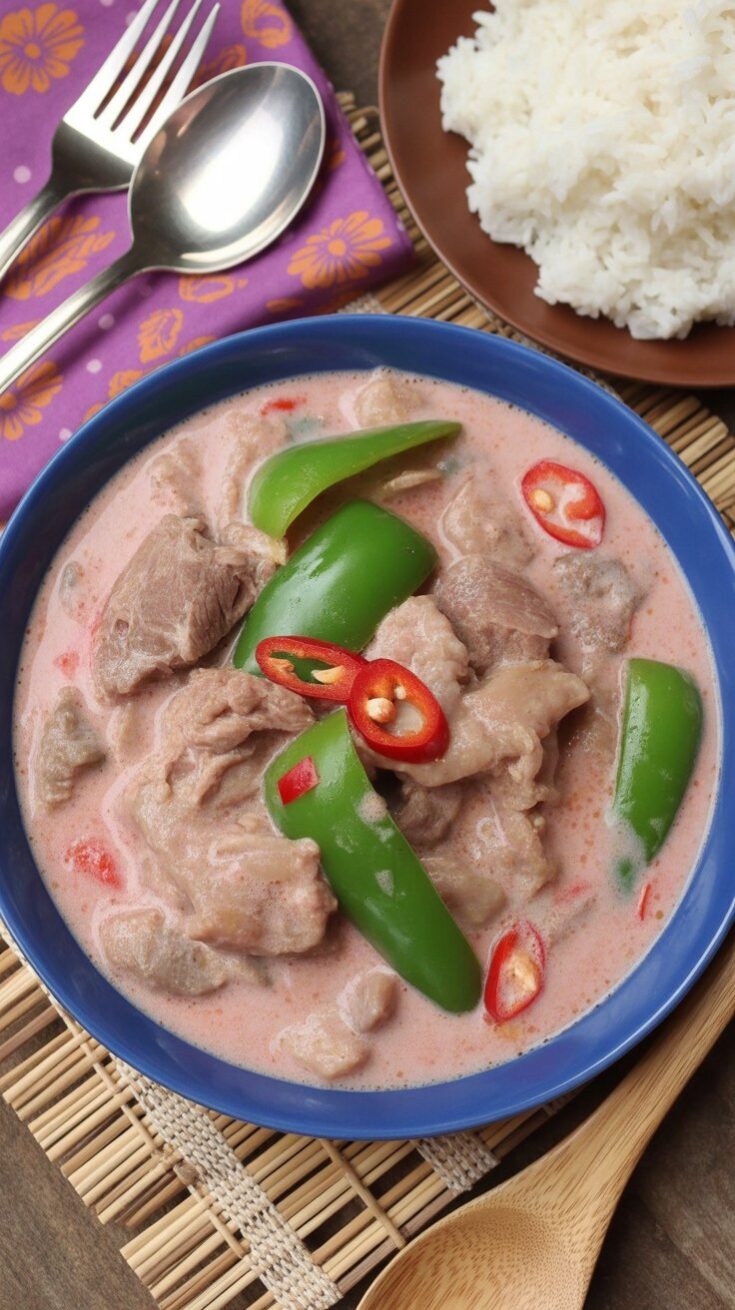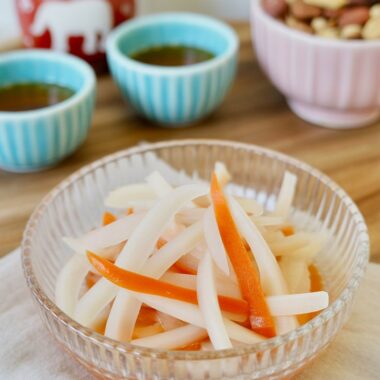If you love creamy, spicy dishes that warm you up from the inside out, then this Filipino classic is one to try. Bicol Express is bold, rich, and packed with flavor — made with tender pork belly simmered in coconut milk and a serious hit of chili heat. This is one of those dishes that isn’t shy about making an impression — and that’s exactly why I love it.

I remember the first time I tasted a true Bicolano version — my tongue was on fire, my eyes were watering, and I still couldn’t stop reaching for another spoonful. It’s the kind of heat that hurts so good.
Why This Dish Has a Cult Following
The magic of Bicol Express is in its balance — creamy coconut milk softens the edges of all that chili heat, while the bagoong (shrimp paste) adds an intense, savory backbone. It’s the kind of dish that keeps surprising you with every bite.
I once packed a mild version of this for lunch at work, feeling proud. A Bicolana colleague took one bite, raised an eyebrow, and the next day brought in her own container of what she called “the real stuff.” I couldn’t feel my tongue for an hour — but I’ve been chasing that flavor ever since.

Ingredients You’ll Need (and a Few Swaps if You Must)
Here’s what I usually grab when making this dish:
- Pork belly – The fat melts into the sauce and adds unbeatable richness. If you want to cut down on the grease, pork shoulder works too, though you’ll sacrifice a little of that melt-in-your-mouth factor.
- Coconut milk & coconut cream – You’ll use both. The milk forms the base of the sauce, and the cream gets added later for a final touch of richness.
- Fresh shrimp paste (bagoong alamang) – This is non-negotiable for that punchy umami. If you only have access to the neon-pink bottled stuff, rinse it briefly and drain before using.
- Chili peppers – Thai red chilis for heat, and long finger chilis (siling haba) for body and a gentler heat. Use as many as you dare — or less if you’re cooking for kids.
- Aromatics – Garlic and onion give the dish its familiar warmth and depth.
- Optional veggies – I sometimes throw in string beans or sigarilyas (winged beans) for extra bite and color.
Tip: Freezing your pork belly for 30 minutes makes it way easier to slice into even cubes.
How I Cook Bicol Express at Home
I’ve played around with this dish over the years, and here’s the version that works best for me:
- Brown the pork: Start by sautéing onion and garlic in a wide pan with a bit of oil. Once soft, add in the pork belly and sear it until it’s golden on the edges.
- Add the shrimp paste: Stir it in and let it cook for a few minutes to mellow out the saltiness and deepen the flavor.
- Pour in the coconut milk and water: Bring it to a gentle simmer — not a rapid boil, or you risk curdling the milk. Let the pork cook slowly until it’s tender.
- Add the heat: Toss in your chopped chili peppers and continue simmering uncovered until the sauce thickens and starts to release oil.
- Finish with coconut cream and finger chilis: Simmer a few more minutes until it all comes together. The sauce should be creamy and cling to the pork.
Don’t rush it. Let it bubble gently and coax out all those flavors — you’ll thank yourself later.

Kitchen Notes from Experience
- If you’re worried about the spice level, start small. You can always add more later — but you can’t take it back.
- Let it sit for 10–15 minutes after cooking. Like most stews, it tastes better once it settles.
- Make it with chicken if pork’s not your thing. Just use skin-on thighs and cook them until fall-apart tender.
Serving Ideas from My Kitchen
We always serve this with a big heap of steamed white rice — jasmine rice, preferably. The rice soaks up that rich, spicy sauce beautifully. Some folks enjoy it with garlic fried rice, which takes it to another level.
If I’m making this for a weekend lunch, I sometimes pair it with a side of blanched greens or even fresh cucumber to help tame the heat a little. A cold soda doesn’t hurt either.
Storage and Reheating Tips
I’ll be honest — this isn’t a dish that sits out well, especially in warm weather. The coconut milk turns quickly, so here’s what I do:
- Fridge: Store leftovers in a sealed container. It stays good for up to 3 days.
- Freezer: You can freeze it for up to 2 months. Just know the sauce might look a bit grainy when reheated — still tasty, just not as silky.
- Reheating: Use low heat on the stovetop or microwave in short bursts, stirring in between. Add a splash of water or coconut milk if the sauce thickens too much.
Bicol Express

If there's one dish that always hits home for me, it’s Bicol Express. It’s creamy, fiery, and loaded with pork belly that melts in your mouth.
Ingredients
- 2 pounds pork belly, cut into 1-inch cubes
- 1 tablespoon oil
- 4 cloves garlic, finely minced
- 1 onion, thinly sliced
- 2 tablespoons fresh shrimp paste (bagoong)
- 1 can (13.5 oz) coconut milk
- 1 cup water
- 14 Thai chili peppers, minced (adjust to your heat preference)
- 2 cups finger chilies (siling haba), sliced
- 1 cup coconut cream (for finishing)
- Salt and pepper, to taste
Instructions
- Start by heating the oil in a wide, heavy-bottomed pot over medium heat. Toss in the garlic and onion, and sauté until everything smells sweet and the onions turn soft and golden.
- Add the pork belly and give it time to brown slightly—this step builds a rich base of flavor, so don’t rush it. Once the pork has picked up a bit of color, stir in the shrimp paste and let it cook for a minute or two until fragrant.
- Pour in the coconut milk and water, then stir in the chopped Thai chilies. Bring the mixture to a gentle simmer—not a boil—and let it cook uncovered until the pork is nice and tender and the sauce has reduced and thickened slightly, about 35–40 minutes.
- Toss in the sliced finger chilies and stir them in. After a couple of minutes, pour in the coconut cream and let the whole pot simmer again until the sauce becomes thick, rich, and glossy with fat starting to rise to the top.
- Taste and season with salt and pepper. Serve hot with freshly steamed rice—perfect for soaking up every bit of that creamy-spicy goodness.
Notes
- Pork slicing tip: If the pork belly is too soft to slice neatly, pop it in the freezer for 20–30 minutes until it's firm but not frozen solid.
- Shrimp paste substitute: Using bottled shrimp paste from the U.S.? Rinse and drain it first to remove the extra salt and that overly bright pink hue.
- Creamy sauce tip: Coconut milk can curdle if boiled too hard. Keep your heat on low and simmer gently for the creamiest results.
- Want veggies? Add long beans (sitaw), winged beans (sigarilyas), or even green beans for extra texture and flavor.
Nutrition Information:
Yield: 6 Serving Size: 1Amount Per Serving: Calories: 735Total Fat: 44gSaturated Fat: 20gTrans Fat: 0gUnsaturated Fat: 23gCholesterol: 139mgSodium: 249mgCarbohydrates: 44gFiber: 3gSugar: 36gProtein: 41g
Asianplated.com, occasionally offers nutritional information for recipes contained on this site. This information is provided as a courtesy and is an estimate only. This information comes from online calculators. Although allchickenrecipes.com attempts to provide accurate nutritional information, these figures are only estimates.
Common Questions I Get
Is this the same as Laing?
Nope — although both are spicy and creamy Bicolano dishes, laing uses dried taro leaves and has a more earthy, leafy flavor. Bicol Express is all about meat and heat.
Can I use canned coconut milk and cream?
Yes, that’s what I always use. Just don’t shake the can too much — that thick cream at the top is gold.
What if I can’t find fresh shrimp paste?
If all you can get is the bottled stuff, rinse it first and drain it well. It’s a bit more intense in flavor and saltiness, so go easy at first and adjust.
If you’ve never tried Bicol Express, it’s worth making once — even if it’s just to test your spice tolerance. It’s bold, unapologetic, and full of heart, just like the region it comes from.
Try other Filipino recipes:


















